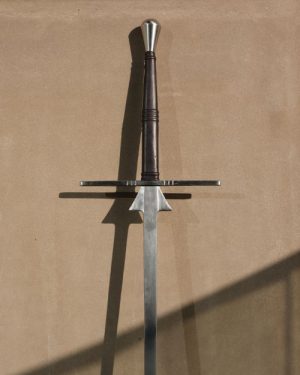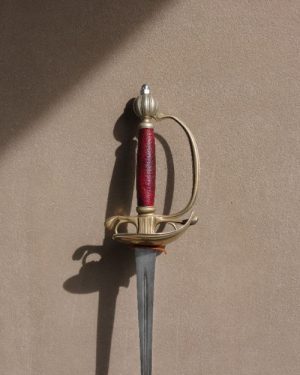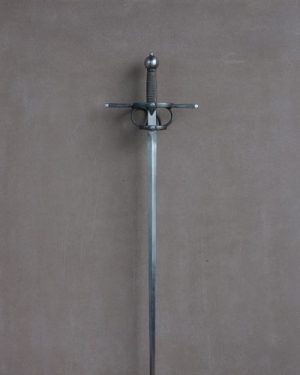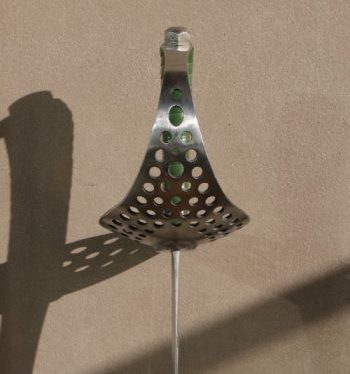When you think of a swordfight, what do you imagine? Perhaps you see noble knights locked in combat with two-handed longswords or maybe bold musketeers fighting with flashing rapiers and whirling capes. It could be elegant gentry duelling at dawn with subtle and deadly smallswords or the brutal cut and thrust of soldiers’ sabres on the battlefield.
LHFC offers classes in each of these swordfighting traditions, derived from the historical treatises written by the fencing masters of the time. To help you decide which you want to learn, here is a rundown of what you can expect from the different weapons and their classes.
We have suggested some films that you might associate the swords with but you should remember we are not teaching stage combat, which is its own discipline, and swordplay can look quite different when bodies are targets.

Longsword
Length: From the floor to between the navel and armpit
Weight: ~1.5kg
Blade: Cut and thrust
Use: 2 handed
Found in: Robin Hood, Lord of the Rings, Game of Thrones
The longsword is the two-handed cruciform sword of the later middle-ages, seeing use both on and off the battlefield, and was even used in judicial trial by combat, as well as private duels. Carried throughout Europe for hundreds of years, it is a practical and versatile weapon, both lighter and faster than its modern reputation might suggest, utilising the full range of distance, including close play and grappling.
LHFC teaches styles derived from Italian masters Fiore De Liberi and Philippo Vadi.

Smallsword
Length: From the floor to between between the hip and navel
Weight: ~300g
Blade: Thrust only
Use: Single handed, occasionally with off-hand dagger, cloak, lantern, pistol etc.
Found in: The Count of Monte Cristo, Hook, The Duellists
The smallsword is the favoured duelling weapon of the Enlightenment. Descended from the rapier and the ancestor of the modern epee, it lacks a cutting edge but with its wickedly sharp point it is light, fast and fabulous. Although largely associated with intricate salle fencing, demonstrating deportment, poise and a certain languid sophistication, beneath its refined veneer it conceals hidden depths of deadly cunning and ruthless skulduggery.
LHFC teaches styles derived from the French school of Domenico Angelo, supplemented by other masters of the 17th and 18th centuries.

Rapier
Length: From the floor to between the navel and armpit
Weight: ~1 – 1.5kg
Blade: Primarily thrusting, but can cut
Use: Single-handed, with off-hand dagger, cloak, buckler etc.
Found in: Romeo and Juliet, Three Musketeers, The Princess Bride
The Rapier is the one-handed, complex-hilted civilian sword of the Renaissance. Although undeniably elegant, it is heavier than commonly assumed; its reputation for speed comes from its capacity for nimble point control and subtle movement, applied with precise and scholarly, even scientific accuracy. Suited both for duels of honour and self-defence against ruffians, it adorned the hips of refined European aristocrats and gentry in the sixteenth and seventeenth centuries.
LHFC primarily focuses on Northern Italian masters such as Niccoletto Giganti, Salvator Fabris and Ridolfo Capoferro. Although usually used alone, classes sometimes pair the rapier with a cloak or dagger carried in the off-hand.

Sabre
Length: From the floor to between between the hip and navel
Weight: ~700 – 900g
Blade: Cut and thrust
Use: Single-handed, occasionally with a pistol
Found in: Black Sails, Sharpe, The Mark of Zorro
The sabre is the 18th and 19th century soldier’s sword of choice. Born out of the convergence of the heavily curved Eastern European sabres and single-edged backswords of Western Europe, the sabre became a common sight in European militaries for its versatility and durability. Wielded by infantry and cavalry alike, sabres were also used in duels by officers and civilians to settle disputes. Sabre fencing is a scientific, systematic art, adding a dash of military discipline to our swordfighting traditions.
LHFC primarily teaches British sources, such as Alfred Hutton (late 1800s), Charles Roworth (late 1700s-early 1800s), as well as American sources from the 19th century.
Fiore – the complete system
Length: 1.5ft (dagger) to 7ft (spear)
Weight: 350g (dagger) to 2.6kg+ (Poleaxe)
Blade: Cut, thrust, crush and dislocate!
Use: Empty hands, one hand, two hands
Found in: The Last Duel, Henry V, The King, Game of Thrones
Can’t decide between the swords above? Why limit yourself?! In the Mixed Weapons class, we study the full range of a medieval knight’s personal arsenal. Get up close and personal with wrestling and the vicious rondel dagger, keep your options open with the longsword or the poleaxe, or stick it to your foes from a safe distance with the spear – ‘Armizare’ (Skill at Arms) has it all!
LHFC studies Mixed Weapons according to the teachings of Fiore dei Liberi, a master at arms who instructed Italian nobles around the turn of the 15th century.